Christiansfeld, a Moravian Church Settlement: Christiansfeld is a town in Denmark situated about 15 km south of Kolding. Christiansfeld was founded in 1773 by the Moravian Church, also known as Moravian Brethren or Moravians. The Moravian Church had its origin in Bohemia and Moravia, it considers itself to be the oldest Protestant Church, they rebelled against the Roman Catholic Church several years before Martin Luther. A bitter and long religious persecution led to the spread of the Moravians, they found refuge in Germany, Denmark and the Netherlands. Nowadays, the Moravian Church is spread all over the world. Christiansfeld is one of the best preserved Moravian Church Settlement in the world. The town is named after the Danish King Christian VII. The democratic organization of the Moravians is expressed in the humanistic town planning. The Moravians built a town with connected architecture, they built houses of yellow brick with red tiled roofs. The streets were laid out in a grid pattern and lined with linden trees, the linden trees were transported from the Netherlands in 1773. The most important buildings surround the Church Square. Herrnhut, the first settlement of the Moravian Church in Germany, was used as an example for the construction of Christiansfeld. Christiansfeld is located about 55 km from the World Heritage in Jelling. Christiansfeld, a Moravian Church Settlement gained the status as a UNESCO World Heritage in 2015.
www.werelderfgoedfotos.nl © Copyright World Heritage Photos
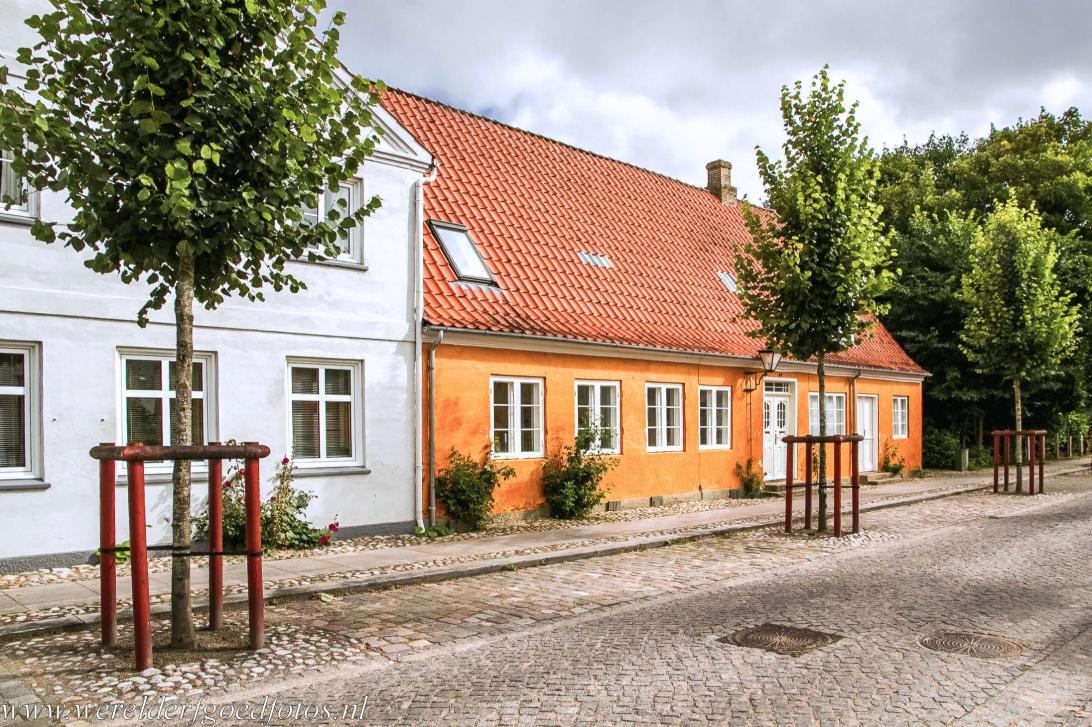
Christiansfeld, a Moravian Church Settlement, is situated in south Jutland in Denmark. The town of Christiansfeld was founded in 1773 by the Moravian Church. Herrnhut, the first settlement of the Moravian Church in Germany, was used as an example for the construction of Christiansfeld in Denmark. The streets were laid out in a grid pattern and linden trees were planted along the streets. The architecture of Christiansfeld is homogeneous and almost unadorned.

Christiansfeld, a Moravian Church Settlement, is situated in south Jutland in Denmark. The town of Christiansfeld was founded in 1773 by the Moravian Church. Herrnhut, the first settlement of the Moravian Church in Germany, was used as an example for the construction of Christiansfeld in Denmark. The streets were laid out in a grid pattern and linden trees were planted along the streets. The architecture of Christiansfeld is homogeneous and almost unadorned.
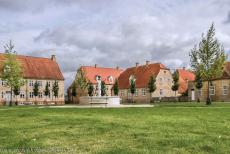
Christiansfeld, a Moravian Church Settlement: The Kirkepladsen is the Church Square. The town is constructed around the central Church Square. Linden trees were planted around the square. The well supplied Christiansfeld with fresh water coming from a spring outside the town, from this spring the water was led to the well by a water supply system. The well is the symbol of the Coat of Arms of Christiansfeld. The Kirkepladsen is surrounded by the most important buildings, among them the Moravian Church Hall, the Salshuset.
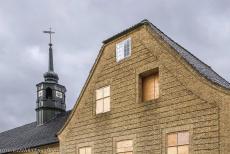
Christiansfeld, a Moravian Church Settlement: The Moravian Church Hall is called the Salshuset. The Moravian Church Hall was built in 1776 and expanded in 1796. The Salshuset is the largest church hall without supporting columns in Denmark and it can accommodate 1000 people. The interior is kept entirely in white and is simply furnished, there are no decorations to disturb the tranquility. The Moravian Church is a Protestant Christian denomination.
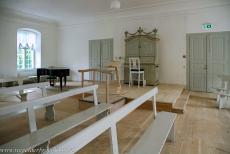
Christiansfeld, a Moravian Church Settlement: The Saal, the worship room in the Sisters' House. During our visit the Salshuset (Moravian Church Hall) was renovated, but it was possible to visit the worship room in the Sisters' House. This worship room is similar to the Saal in the Moravian Church Hall. Worldwide, most of the Moravian Church Halls resemble each other. Christiansfeld, a Moravian Church Settlement, was declared a UNESCO World Heritage in 2915.
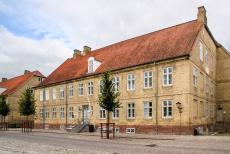
Christiansfeld, a Moravian Church Settlement: The Sisters' House. The adult members of the Moravian Church call themselves Brothers and Sisters. Christiansfeld was originally divided in a section for the Sisters and a section for the Brothers. The Sisters' House dates from 1776. Now, the yellow brick building houses the Moravian Church Museum and the Cultural Heritage Centre of Christiansfeld. Inside, the staircase features a decorative wrought iron railing.
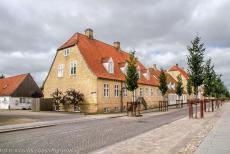
Christiansfeld, a Moravian Church Settlement: Christiansfeld is named after King Christian VII of Denmark, he allowed the Moravians to settle in Denmark in 1773, the members of the Moravian Church, also known as the Moravian Brethren or Hernhutters, were experienced craftsmen and traders, King Christian needed their expertise. Christiansfeld is one of the most well preserved Moravian Church Settlements in the world.
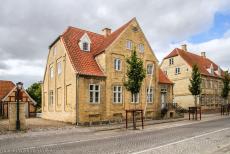
Christiansfeld, a Moravian Church Settlement: The Briant's House was the vicarage. The house was built in 1773 for one of the founders of Christiansfeld, Jonathan Briant. The wrought iron railing on the stairs is among the most beautiful in Christiansfeld. The Briant's House is situated on the Church Square, just like the Moravian Church Hall, the Salshuset, and the first house that was built in Christiansfeld.
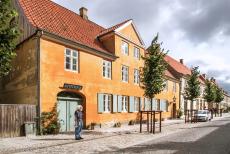
Christiansfeld, a Moravian Church Settlement: The former pharmacy was built in 1783, the building housed once one of the oldest pharmacies in Denmark. Now, the former pharmacy is a café and restaurant, called the 'Det Gamle Apotek', the Old Pharmacy. The historic linden trees from the 1700s were affected by rotting, all of them had to be replaced in 2013. Christiansfeld, a Moravian Church Settlement was inscribed on the UNESCO World Heritage List in 2015.
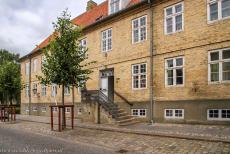
Christiansfeld, a Moravian Church Settlement: The Enkehuset, the Widows' House, the building dates from 1780 and was used as the residence for the elder spinsters and widows. The sisters from the neighboring Sisters' House cared for the elderly and the widows. The members of the Moravian Church are also called Moravian Brethren or Hernhutters. They founded Moravian Church Settlements in many countries, such as in the Netherlands, Germany and Switzerland.
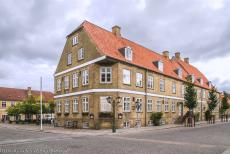
Christiansfeld, a Moravian Church Settlement in Denmark: The Moravian Brethren's Hotel was built in 1773, the building served as a guest house for the members of the Moravian Church. It was turned into a hotel in the middle of the 19th century. On the front façade of the hotel is a commemorative plaque to mark the visit of important royal guests. In this hotel, the ceasefire agreement between Denmark and Prussia was signed in 1864.
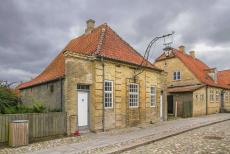
Christiansfeld, a Moravian Church Settlement: This picturesque gable house was built in 1778, it was used as the Night Watchman's House and fire station. Much later, the Danish painter Jeppe Madsen Ohlsen, who was born in Christiansfeld in 1891, lived in the house. The first house built in Christiansfeld is located at Lindegade 17 (on the right hand), the first stone was laid on April 1, 1773. The house was used as a church until the Moravian Church Hall was ready.
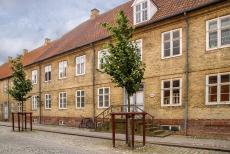
Christiansfeld, a Moravian Church Settlement: The Brothers' House was built in 1774. The house was the residence for unmarried men, it also contained several workshops and small factories, the products were known for their high quality. Christiansfeld is also famous for its honey cakes. The first honey cakes were produced in the bakery of the Brothers' House.
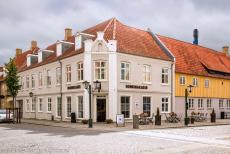
Christiansfeld, a Moravian Church Settlement in Denmark: The Moravian Honey Cake Bakery was built in 1782. Christiansfeld is famous for its honey cakes, the honey cakes are still baked to a recipe from 1783. Most of the houses in Christiansfeld were built of yellow brick with red tiled roofs. The houses are still inhabited by the descendants of the first inhabitants of Christiansfeld.
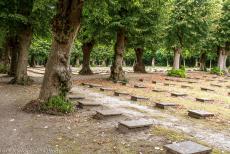
Christiansfeld, a Moravian Church Settlement: The 'Gudsageren', the God's Acre, is the Moravian cemetery, it is laid out in the shape of a cross. Family members are not buried together, women are buried to the right, men are buried to the left. The graves are identical as a symbol that after death all men are equal. All the graves are preserved. The first burial took place in 1774, a little boy who died at sea during the voyage with his parents, they came from the Moravian Church Settlement at Zeist in the Netherlands.
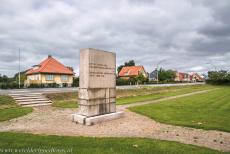
Christiansfeld, a Moravian Church Settlement: The Reunion Monument on Reunification Square. The stone was erected to commemorate the Reunification of 10 July 1920, when South-Jutland was reunited with Denmark after 56 years of Prussian-German rule. A relief on the front side of the memorial depicts the symbolic image of Mother Denmark welcoming her robbed daughter South-Jutland. Christiansfeld, a Moravian Church Settlement is a UNESCO World Heritage.
